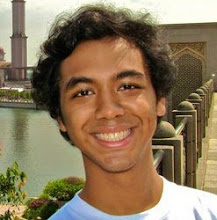Roughly three months ago, Indonesian cities are deluged in their posters, stickers, and banners. They smiled at us from the side of the road, stared at us from walls, and covered every reachable surface. Their presence is almost Big Brother-esque. Without being asked, they told us their names and flaunted all their academic degrees regardless of where and how they got them. Some went further and photoshopped themselves with Obama, Beckham, and Superman. Others were more clueless. And being the cheeky people that we are, we made fun of them again and again and again.
Now, they are gone as fast as a shady reality show star. But wait, who are they that we are talking about?
No, they are not Tukul or Manohara and her greedy mother or Kangen Band. I will seriously sound a lot happier than this if they are gone. Right now, I am talking about our former legislative candidates - more specifically, the tiny percentage of them who had graduated to become members of our legislatures from the lowest level to the highest.
We can remember their omnipresence in the times before the election. You can find them hung between electricity lines, nailed to the trees, glued to the nooks and crannies of the city, and stuck to bajajs, buses, and hawkers’ stalls. Following worldwide trend, the uniting theme was “change” and “youth”. Virtually all the candidates tried to exploit that theme, even if he/she is -or looks like- a septuagenarian from an old-skool political party.
Let it be the thing of the past, although you can still laugh at the absurdity for years to come. What matters is that we already have our representatives-elect from all the electoral districts. According to the news, KPU is still in hot water after a Supreme Court decision regarding the allocation of DPR seats, not to mention the boiling ocean it has been in for their blatant ineptitude in organizing the elections. Let’s skip that part mostly because I don’t grasp what is actually going on. For now, I want to express an idea involving the elected guys.
For the sake of clarity, I am using the terms MP and lawmakers for members of the MPR, the bicameral parliament which consists of DPR and DPD; representative (rep) for members of DPR; and senator for members of DPD. If you know the official translation for those offices, please let me know. And despite this paragraph, I guess I will accidentally mix those terms up anyway.
I’m no politician or political analyst, fortunately. However, I believe I have more or less grasped the concept of representation in the parliament. In Indonesia, citizens of an electoral district are represented in DPR by several reps from different parties and in the DPD by four senators from each province. In lower levels, there are DPR’s in the provincial and regency level. By definition, to represent someone is to speak and act with authority in his/her behalf. Hence, when a district says it wants to outlaw Kangen Band, its MPs should fight for the noble cause in their respective legislatures. In turn, MPs should do a show-and-tell about what they have done in office to their constituents. A little boasting is also welcomed.
People living in developed democracy can understandably take that for granted. They have access to their MPs and their MPs regularly reach out to them. On the other hand, Indonesian voters do not enjoy the level of transparency and accountability a democracy should provide. I personally felt that when I stayed in my aunt’s house in Melbourne. During the month-long vacation, I found out that she receives letters, brochures, and many other publications from her MPs in both the state and federal legislature. I also happen to pass the offices of MPs in the area. Facebook opened my eyes on this matter as well. Because I am a fan of Barack Obama on the site, I get frequent updates and on those updates, the writer urged people to call or mail their own reps to convey a united message.
Those experiences sparked some thinking and questioning. I have been an Indonesian for more than 18 years and nearly all my family members are Indonesians, yet we never come into contact with any of our representatives. I confidently assume that most Indonesians also feel that way. How can they fight for our causes and believes when they don’t even know it? If we want to tell them, how can we do it? It is not so strange when people have the impression that MPs spend too much time hanging out with the big boys, and too little with the ordinary Anto or Joko or David.
Until now, our reps are almost strictly party-line voters, even when they and their constituents stand for something different from what the party wants. A recent example would be the controversial Porn Law, which got the nod from all but two factions in DPR (PDI-P and PDS). Many members betrayed the wish of their constituents from provinces that strongly rejected the bill simply because their parties wanted them to vote yes. One particular representative from Golkar came clean in a Jakarta Post article. This tragedy must never happen again in Indonesia.
I propose that the next members of our legislatures start making huge waves of change in how political representation works. Scratch that. To make political representation work will be more accurate. First, having offices in the district each one of them represents is a minimal. That way, we can get in touch with them and they can reach us. This office must be able to absorb the district’s general opinion regarding a matter, whether by asking or by listening; then relay that opinion to the MP so that he/she can represent it in the legislature. This office will also be responsible for the dissemination of information concerning what the MP has done.
Second, a strong presence in the cyberspace is needed to top off the presence in meatspace. After Obama’s brilliant online campaign, any politician who has a decent website will be accused of stealing a thing or two from Obama’s recipe book. Just don’t listen to this pointless accusation. Everyone will catch up with the trend, eventually; it’s not like Obama invented the internet. Conquering the internet will be even more crucial for MPs representing urban areas, while MPs from rural areas can always have a head start before the constituent gets into teh interwebs through series of tubes. For starters, an official page on Facebook or regular tweeting is acceptable, but it is certainly better if MPs employ local web designers to set up a dynamic, interactive, and up-to-date website.
Additionally, an MP must be extra sensitive about the goings-on in the net. We have to thank YouTube for making it obscenely easy to exaggerate a problem and amass support for it. A frustrated voter who chooses to let hell loose on YouTube can be the undoing of a representative or two. Apart from nipping troubles in the bud, an MP must be cool and hip. What the what, you say. Obviously I don’t expect my MPs to have a burning love for Miley Cyrus or the Jonas Brothers. Being cool and hip is, in this context, being able to grasp the general mood of the people and know what internet meme is growing fast. It may sound silly, but it won’t be when an MP’s gaffe evolves into a world-famous meme and politicians fail to catch it.
Third, MPs must not be afraid of getting down and dirty. They should hold a town hall meeting (the town hall part is figurative, of course) on a regular basis with the people they claim to represent. Constituents will have a chance to vent out whatever issues they have and to check whether the MP has done his job. MPs will, in return, get an opportunity to expound on the policies he makes and convince the people that it is suitable and beneficial for them.
Making these three changes will bring an unprecedented positive change to our politics. The people will be more properly represented in the legislature and enjoy a sense of being in touch with the extension of their voices. Decisions made in the representative bodies will then reflect what the people want even better. Voters will have an established channel to directly send their messages, lodge a complaint, express their outrage, and show their support to the legislative. For example, I would be able to share my love-hate TransJakarta relationship with the provincial representative from South Jakarta and tell them what I think needs to be fixed.
More importantly, constituents can demand greater accountability from their reps. They will have access to where the lawmakers stand on various issues and how they voted a bill. If the people find out that the lawmaker had voted against their wish, they can ask why after giving him/her the benefit of a doubt and a chance to explain that difference.
For the politician, breaking down the walls that separate them from voters will similarly bring its own benefits. It would be easier for MPs to sense the people’s collective vibe, whether they are satisfied or not with how things are going. Problems can be detected earlier and taken care of before blowing up into pure mess, which would damage a politician’s reputation the same way Simon Cowell ruins an auditioner’s day.
The other way around, an MP can use the channel of communication with his/her constituent to report on what have been done and voted in the legislature. A little self-advertising won’t hurt because an MP does deserve praise if he/she does a great work. “The Hon. Mr. X, MP have argued and voted for more spending on school infrastructure” or “The Hon. Mrs. Y, MP rejected bill on legalizing polygamy” - I personally wouldn’t mind getting updates on the successes of the guys who claim to be my voice in the government. Later, this will be an advantage if the MP is seeking another term in office because the people have known this MP’s performance.
The next members of Indonesia’s legislatures haven’t been sworn-in, but I already have high hopes that the “change” that they boasted to bring since the campaign days are not mere repetition of Obama’s buzzword, but real positive change for a better Indonesia.




